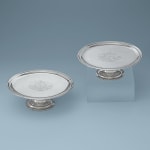



Paul de Lamerie
Weight: 25 oz. 1 dwt.
Further images
The Huguenot bona fides on this are pretty simple: Lamerie. But the more interesting aspect of this particular pair of tazzas is the client.
The arms are those of Treby, for Sir George Treby, one of Lamerie’s greatest patrons. He is of particular interest to collectors, scholars, and silver enthusiasts generally, because he was the owner of two of the greatest pieces to have survived from Lamerie’s workshop: the Treby punch bowl, and the Treby toilet service. Both pieces are at the Ashmolean as part of the magnificent Farrer bequest.
These tazze were originally a set of six, and when they were split up one pair was sold—likely by us or by S.J. Phillips—to our irascible client, Irwin Untermyer. In the catalog of the Untermyer collection, Yvonne Hackenbroch writes (in highly Teutonic style):
“Next in date is a pair of salvers on foot, made in 1720 (no. 172), engraved with the arms of one of Lamerie’s greatest patrons, the Rt. Hon. George Treby, M.P. The original invoice, dated April 25, 1721, survives. These salvers are therefore earlier than Lamerie’s famous toilet service in the Ashmolean Museum, ordered by Treby as a wedding present for his wife, Charity Hele, in 1724. Lamerie’s unfailing sense of proportion and his capacity for organization are manifest in these early pieces and confirm the range of this master, who, later in life, excelled in the virtuosity of elaborate creations.”



